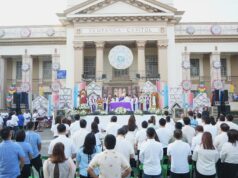CITY OF SAN FERNANDO—Where exactly is your land located? Where are its bounds?
Small and big landowners including local governments in Central Luzon expect to get more accurate answers because a project delayed by 15 years has covered much since it was resumed in 2007, an official of the Department of Environment and Natural Resources said.
The basic instrument of locating real properties——geodetic control points (GCP) or simply, mojon—is in place, at least half of them as of November, DENR regional executive director Ricardo Calderon said.
According to Calderon, the continuation of the Philippine Reference System of 1992 (PRS92) has established 311 new mojons in Bataan and Zambales.
At least 350 more new mojons are due for installations in Pampanga, Bulacan and Tarlac before December ends.
Old mojons, totalling 164 in Nueva Ecja and Zambales, have been recovered. The DENR is restoring 252 more in Pampanga and Bulacan, according to Engr. Artemio Almazan, head of the agency’s regional composite survey team.
Mojons, either circular or rectangular, are made of concrete. Geographic information, obtained via satellite, are inscribed on these as they are on private or public lands.
Mojons used to be placed kilometers apart to establish the territories or boundaries of provinces, towns, cities, villages and lots, Calderon said.
Because there are additional mojons, the time and cost of surveying are expected to decrease, Almazan said.
“This [PSR92] is a very important component of cadastral projects,” Calderon said, referring to land surveys. Such projects were devolved to local governments until these were returned to the DENR, especially its lands management bureau, it was learned.
Calderon said mojons are significant in areas buried by Mt. Pinatubo’s eruptions in 1991 and lahar seasons in 1991 to 1997, Calderon said, referring to Pampanga, Tarlac and Zambales.
These are also needed in villages that, after many centuries, have not been surveyed. These are in portions of Olongapo City in Zambales, Pandi and Obando in Bulacan and Nampicuan in Nueva Ecija.
“What we are having are permanent reference points so that we avoid erroneous land surveys that lead to land conflicts in the court,” he said.
A GPS (global positioning system) is used to determine the exact location, elevation, boundary and coordinates of an area.
The DENR and the state-owned firms Clark Development Corp. and Clark International Airport Corp. are signing a memorandum allowing for the establishment of 62 mojons within 28,000 hectares of the Clark Freeport and Clark Special Economic Zone (also known as New Frontier or Sacobia.
Small and big landowners including local governments in Central Luzon expect to get more accurate answers because a project delayed by 15 years has covered much since it was resumed in 2007, an official of the Department of Environment and Natural Resources said.
The basic instrument of locating real properties——geodetic control points (GCP) or simply, mojon—is in place, at least half of them as of November, DENR regional executive director Ricardo Calderon said.
According to Calderon, the continuation of the Philippine Reference System of 1992 (PRS92) has established 311 new mojons in Bataan and Zambales.
At least 350 more new mojons are due for installations in Pampanga, Bulacan and Tarlac before December ends.
Old mojons, totalling 164 in Nueva Ecja and Zambales, have been recovered. The DENR is restoring 252 more in Pampanga and Bulacan, according to Engr. Artemio Almazan, head of the agency’s regional composite survey team.
Mojons, either circular or rectangular, are made of concrete. Geographic information, obtained via satellite, are inscribed on these as they are on private or public lands.
Mojons used to be placed kilometers apart to establish the territories or boundaries of provinces, towns, cities, villages and lots, Calderon said.
Because there are additional mojons, the time and cost of surveying are expected to decrease, Almazan said.
“This [PSR92] is a very important component of cadastral projects,” Calderon said, referring to land surveys. Such projects were devolved to local governments until these were returned to the DENR, especially its lands management bureau, it was learned.
Calderon said mojons are significant in areas buried by Mt. Pinatubo’s eruptions in 1991 and lahar seasons in 1991 to 1997, Calderon said, referring to Pampanga, Tarlac and Zambales.
These are also needed in villages that, after many centuries, have not been surveyed. These are in portions of Olongapo City in Zambales, Pandi and Obando in Bulacan and Nampicuan in Nueva Ecija.
“What we are having are permanent reference points so that we avoid erroneous land surveys that lead to land conflicts in the court,” he said.
A GPS (global positioning system) is used to determine the exact location, elevation, boundary and coordinates of an area.
The DENR and the state-owned firms Clark Development Corp. and Clark International Airport Corp. are signing a memorandum allowing for the establishment of 62 mojons within 28,000 hectares of the Clark Freeport and Clark Special Economic Zone (also known as New Frontier or Sacobia.




